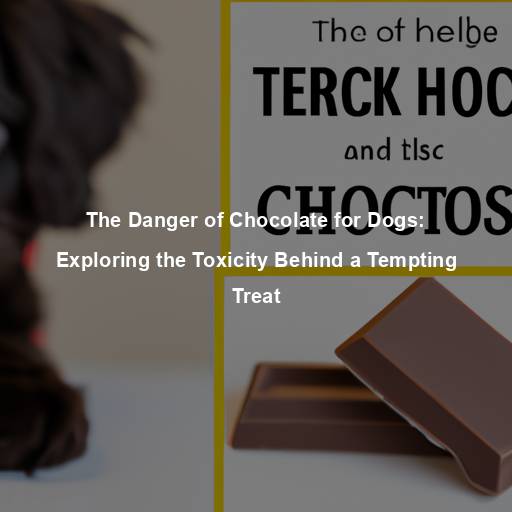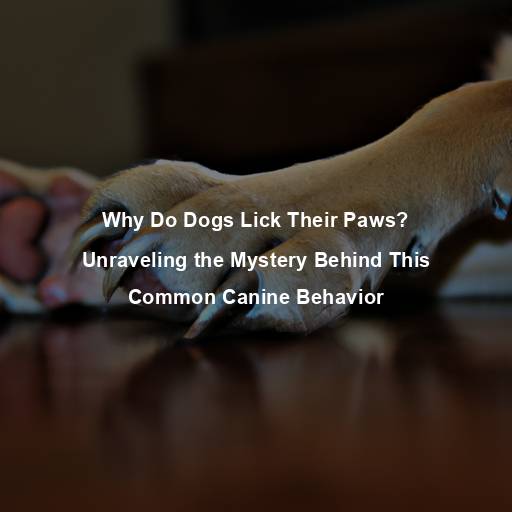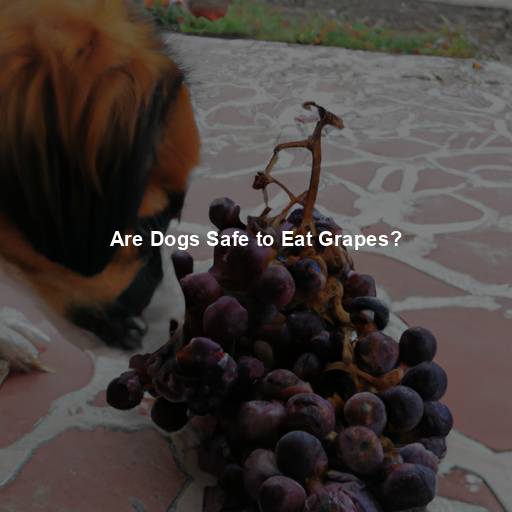The Danger of Chocolate for Dogs: Exploring the Toxicity Behind a Tempting Treat
Last Updated on November 7, 2023 by Evan
Contents
- 1 Understanding the Canine Digestive System
- 1.1 The Temptation of Chocolate: Why Dogs Can’t Resist
- 1.2 The Lethal Lure: Theobromine Toxicity
- 1.3 Unleashing the Dangers: Symptoms of Chocolate Toxicity
- 1.4 The Power of Prevention: Keeping Chocolate Out of Reach
- 1.5 When Accidents Happen: Immediate Action is Vital
- 1.6 Preventing a Bitter End: The Importance of Timely Treatment
- 1.7 Educating for a Safer Future: Spreading Awareness
- 1.8 A Final Note: The Ultimate Act of Love
- 1.9 Understanding the Role of Theobromine
- 1.10 Metabolism Differences: Dogs vs. Humans
- 1.11 Size Matters: Impact of Body Weight
- 1.12 The Darker the Chocolate, the Greater the Danger
- 1.13 Cracking the Code: Signs and Symptoms of Chocolate Toxicity
- 1.14 No Chocolate Treats: Alternative Delights for Dogs
- 1.15 A Call for Caution: Keeping Our Canine Companions Safe
- 1.16 A Journey of Vigilance: Seeking Immediate Veterinary Care
- 1.17 Spreading the Word: Advocating for Canine Health
- 1.18 The Gift of Health: Protecting Our Beloved Companions
- 2 FAQs – Why Dogs Can’t Eat Chocolate
Understanding the Canine Digestive System
Dogs have been our faithful companions for centuries, providing us with unconditional love and endless joy. As responsible pet owners, it is our duty to ensure their well-being, which includes understanding what foods are safe and which can pose a threat to their health. One such food that we often enjoy but can be harmful to our furry friends is chocolate.
The Temptation of Chocolate: Why Dogs Can’t Resist
Chocolate has long been a beloved treat for humans, tempting us with its rich flavors and satisfying sweetness. However, what makes chocolate so enticing to us can be extremely dangerous for dogs. This is due to a compound found in chocolate called theobromine, which can have toxic effects on our canine companions.
The Lethal Lure: Theobromine Toxicity
When it comes to chocolate, the theobromine levels can be a real conundrum. It’s an interesting twist that different types of chocolate have varying amounts, with the darker varieties taking the lead. But here’s where it gets perplexing – while theobromine can give us humans a little energy boost, it can wreak havoc on our furry friends, especially dogs. Their bodies struggle to process this stimulating substance, leaving them vulnerable to dangerous levels building up over time.
Unleashing the Dangers: Symptoms of Chocolate Toxicity
When our furry companions accidentally indulge in the forbidden delight of chocolate, they may experience an array of perplexing symptoms, each with its own degree of severity. From restlessness to trembling, excessive thirst to irregular heartbeat, their delicate systems can be thrown into a whirlwind of uncertainty. It is crucial, therefore, to remain vigilant and seek professional guidance to navigate these unexpected adventures in the realm of doggie chocolate mishaps.
A sudden and unanticipated expulsion of stomach contents, vomiting can be an unpleasant and perplexing experience. Whether it’s caused by a stomach bug or food poisoning, the burst of nausea followed by the forceful ejection of gastric fluids can leave one feeling disoriented and bewildered. Regardless of the circumstances, vomiting is undoubtedly an event that can throw us off balance and leave us questioning what caused such an unexpected bodily response.
In a world where the unpredictability of bodily functions can throw us off balance, one particular ailment often catches us by surprise – diarrhea. This seemingly innocuous yet perplexing condition leaves us running to the bathroom, seeking relief from the burst of discomfort that fills our bodies like an unwelcome guest. With its unpredictable nature and ability to disrupt our daily routines, diarrhea continues to perplex and frustrate many, reminding us that even the most routine bodily functions can sometimes throw us into a state of perplexity.
Your heart pounds faster, racing like wild horses on a thrilling journey through your veins. It’s as if your heart has been ignited by an invisible flame, its rhythm dancing in sync with your heightened emotions. In this turbulent symphony of life, each beat becomes a whisper of anticipation, a testament to the exhilaration coursing through your very being.
4. Restlessness and hyperactivity
Witness the extraordinary phenomenon of muscle tremors and seizures, where the body convulses with perplexing intensity. Experience the burst of electrical activity that sparks these bewildering episodes, leaving even the most astute scholars questioning the underlying mechanisms. Delve into the enigmatic realm of neurology as we unravel the intricate tapestry of factors that ignite these mesmerizing physical manifestations, promising to ignite your curiosity with every twist and turn.
Have you ever felt like your body is going haywire? One minute you’re downing water like there’s no tomorrow, and the next you’re spending an unusual amount of time in the bathroom. It’s like your bladder and thirst sensors have suddenly switched into overdrive, leaving you feeling perplexed and constantly reaching for a water bottle. Don’t worry, you’re not alone.
As our hearts dance to the rhythm of life, sometimes they sway to a beat that is out of step. Heart rhythm abnormalities, like a mischievous conductor, can disrupt the harmonious flow of our most vital organ. Amidst the symphony of perplexing palpitations, fluttering, and skipped beats, it is essential to seek the expert guidance of medical professionals who can orchestrate a plan to restore stability to our rhythmic core. Together, we can navigate the labyrinthine pathways of abnormal heart rhythm and embrace a future filled with steady pulses and renewed vitality.
Feeling the heat? If you’ve been experiencing a sudden surge in your body’s temperature, you’re not alone. This perplexing phenomenon has left many feeling the burn, quite literally. Don’t sweat it though, as we delve into the world of elevated body temperature, unraveling the mysteries behind this burst of heat, and providing some helpful tips to keep your cool.
Experiencing difficulty in breathing can be an incredibly distressing and unnerving situation. The sensation of not being able to fully fill one’s lungs with air can leave individuals feeling perplexed and anxious, desperately seeking answers and solutions. The unpredictable nature of respiratory distress further compounds the burst of panic that accompanies it, urging individuals to seek prompt medical attention to alleviate their discomfort and regain a sense of calmness.
The Power of Prevention: Keeping Chocolate Out of Reach
Prevention is key when it comes to protecting our furry companions from the dangers of chocolate. Here are some essential tips to keep in mind:
Stay informed and spread awareness regarding the potential hazards of chocolate for our furry friends. Take the time to educate yourself, as well as your loved ones, about the risks involved and the imperative need to keep this tempting delicacy safely out of their paws. Protecting our pets starts with knowledge and responsibility – let’s make sure everyone is on the same page.
-
Secure Storage: Store chocolate products in secure, elevated locations where your dog cannot access them. Remember, dogs can be crafty and determined when it comes to obtaining a tasty treat.
-
Holiday Hazards: Be particularly cautious during holidays such as Halloween, Christmas, and Easter, when chocolate consumption tends to increase. Keep a close eye on your dog and ensure they are not exposed to any chocolate goodies.
-
Inform Others: Educate your friends, family, and neighbors about the risks of chocolate for dogs. Awareness can go a long way in preventing accidental ingestion.
When Accidents Happen: Immediate Action is Vital
If you find yourself in the worrisome situation where you suspect your beloved furry friend may have indulged in the forbidden delight of chocolate, prompt action becomes the paramount priority. The delicate balance of time and swift intervention holds the key to mitigating the potential harmful repercussions of chocolate toxicity. In order to tackle this perplexing situation, here are the essential steps that demand your undivided attention.
-
Assess the Situation: Determine the type and quantity of chocolate your dog has consumed. This information will be vital for your veterinarian to assess the level of toxicity.
-
Contact a Professional: Call your veterinarian or a pet poison helpline immediately. They will guide you on the necessary steps to take based on your dog’s size, the type of chocolate ingested, and the time that has passed since ingestion.
When it comes to inducing vomiting, it’s crucial to proceed with caution and seek professional guidance. This method shouldn’t be taken lightly, as its safety and effectiveness may vary depending on the situation. Trust your veterinarian to provide you with the best advice and course of action tailored to your specific circumstances.
When it comes to the health of your beloved furry companion, being prepared is key. In the unfortunate event that your dog requires medical intervention due to the consumption of chocolate, it is essential to arm yourself with vital information. Make sure you are equipped with details such as the specific brand of chocolate, the percentage of cocoa involved, and any other pertinent facts that may assist the veterinarian in providing the best care possible. Remember, being proactive and informed can make all the difference in ensuring your dog’s well-being during this perplexing situation.
Preventing a Bitter End: The Importance of Timely Treatment
Timely treatment can make a significant difference in the outcome of chocolate toxicity. When you seek veterinary assistance promptly, they can take appropriate measures to mitigate the effects and provide the necessary medical interventions. Remember, the sooner you act, the better the chances of a positive outcome.
Educating for a Safer Future: Spreading Awareness
Calling all pet enthusiasts and dedicated dog guardians! Brace yourselves for an urgent, eye-opening discussion on a perilous temptation that lurks within our reach: chocolate. It is with profound obligation that we embark on a mission to enlighten and safeguard our four-legged companions from an unforeseen menace that threatens their well-being. Join us as we unravel the mysteries and share our truth, arm in arm, shielding our precious buddies from avoidable pitfalls.
- Social Media: Utilize social media platforms to share informative posts, graphics, and articles about the dangers of chocolate for dogs. Encourage your friends and followers to share the information further.
Looking to dive deep into the realm of pet safety and well-being? Look no further than the plethora of community events that await you! Engage in organizing or participating in these enriching gatherings where you can immerse yourself in a sea of knowledge. This vibrant tapestry of educational workshops and captivating booths will unveil the mysteries behind the potentially treacherous world of food hazards for our beloved four-legged companions.
- School Programs: Collaborate with local schools to introduce educational programs that teach children about responsible pet ownership and the importance of keeping dogs away from harmful foods.
Are you a pet lover? Looking for ways to keep your furry friends safe? We have a suggestion that’ll make tails wag! Why not connect with pet-friendly establishments and spread the word about chocolate toxicity?
A Final Note: The Ultimate Act of Love
As pet owners, we hold the key to our furry companions’ safety and well-being. While it may be tempting to share our favorite treats with our dogs, we must resist the urge and protect them from potentially harmful substances like chocolate. By understanding the dangers, spreading awareness, and taking swift action when accidents occur, we can ensure that our dogs live long, healthy lives filled with love and joy. Remember, the ultimate act of love is keeping them safe from harm, even if it means denying them a taste of our favorite indulgences.
Understanding the Role of Theobromine
Delving into the fascinating complexity of chocolate, we uncover a perplexing truth – its delectable composition comes with a slightly darker side. This scrumptious treat boasts the presence of theobromine, a compound nestled within the intriguing group of methylxanthines. While our human bodies have mastered the art of metabolizing theobromine with relative ease, our canine companions face a more intricate challenge. The disparity lies in their ability, or rather, struggle, to break down this enigmatic substance.
Metabolism Differences: Dogs vs. Humans
Dogs have a slower metabolic rate for theobromine compared to humans, resulting in theobromine accumulating in their system at higher concentrations and remaining in their body for longer periods. This disparity in metabolism is due to a variation in the enzyme responsible for breaking down theobromine, known as cytochrome P450.
Size Matters: Impact of Body Weight
Not only do dogs metabolize theobromine differently, but their size also plays a significant role in determining the extent of toxicity. Smaller breeds have a higher sensitivity to theobromine, as their bodies cannot tolerate the same levels as larger dogs. Therefore, even a small amount of chocolate can have severe consequences for a tiny pup.
The Darker the Chocolate, the Greater the Danger
Did you know that theobromine levels can vary greatly depending on the type of chocolate? It turns out that dark chocolate takes the crown when it comes to theobromine concentration. The reason behind this lies in the higher cocoa content found in dark chocolate, which sets it apart from its milky counterpart. So, if your furry friend happens to have a sweet tooth, be extra cautious with dark chocolate as it could potentially lead to theobromine toxicity.
Cracking the Code: Signs and Symptoms of Chocolate Toxicity
Recognizing the perplexing signals of chocolate toxicity in our furry companions is of utmost importance, demanding swift intervention. These symptoms can appear with erratic timing, leaving us grappling with uncertainty. The severity of these symptoms oscillates, contorting like a kaleidoscope, relying on the volume of chocolate ingested and the unique dimensions of our canine friends.
Mild Symptoms:
- Vomiting
Experience the tumultuous journey of an unruly stomach with our in-depth exploration of a common bodily upheaval. From unpredictable bathroom escapades to the perplexing origins of this digestive dilemma, discover the hidden truths behind this burst of intestinal chaos. Delve into the perplexity of managing an unexpected outbreak while uncovering tried-and-tested remedies to steady the ship in times of gastrointestinal turmoil.
In a world that never sleeps, where constant stimuli bombard our senses, restlessness has become the common thread of our existence. We find ourselves caught in the whirlwind of excitement and chaos, yearning for the next thrill to distract us from our own thoughts. Yet, beneath the surface of our frenzied lives, a sense of unease and yearning lingers, leaving us in a perpetual state of flux. The inexplicable longing for something more, something beyond the ordinary, keeps our hearts racing and our souls perpetually searching. - Increased thirst and urination
Moderate Symptoms:
Take a deep breath and brace yourself for an awe-inspiring journey into the realm of accelerated respiration. As we delve into the intricacies of rapid breathing, we unravel the enigmatic dance between our lungs and the rhythm of life. Prepare to have your lungs fill with curiosity as we explore the fascinating mechanisms behind this perplexing phenomenon. Buckle up, dear readers, as we embark on a thrilling exploration of the breath of life.
– Elevated heart rate
In a world where our bodies are in constant motion, there are moments when our muscles seem to have a mind of their own. A gentle tremor here, an unexpected twitch there – these enigmatic occurrences leave us perplexed and curious. While we seek answers to unravel the secrets behind these bodily phenomena, one thing remains certain: the enigmatic dance of tremors and muscle twitching continues to astound and captivate us.
Do you ever feel like you just can’t sit still, as if your body is constantly vibrating with energy? Or perhaps you find yourself constantly jumping from one task to another, unable to focus for more than a few minutes. Restlessness can be a perplexing state to be in, leaving you feeling both excited and overwhelmed by the sheer volume of thoughts and ideas racing through your mind.
Severe Symptoms:
- Seizures
The enigmatic world of cardiac arrhythmias leaves both patients and doctors alike perplexed. Unpredictable bursts of electrical signals within the heart create a captivating tapestry of irregular heartbeats, leaving individuals uncertain of what lies ahead. With its bewildering array of symptoms and the potential for life-threatening complications, understanding and managing these rhythmic abnormalities remains a constant challenge for the medical community. Nonetheless, strides are being made in unraveling the complexities surrounding cardiac arrhythmias, offering hope for a brighter, more predictable future. - Respiratory distress
In a world riddled with uncertainty and upheaval, there comes a time when we find ourselves at the crossroads of collapse or renewal. The future appears both perplexing and full of bursting potential, forcing us to grapple with the perplexing question of what lies beyond our current state of affairs. Like a dormant volcano on the verge of eruption, our collective consciousness teeters on the edge of collapse, begging us to awaken and embrace the bewildering path towards transformation.
No Chocolate Treats: Alternative Delights for Dogs
While chocolate may be off the menu for dogs, there are plenty of safe and enjoyable alternatives to indulge their taste buds. Consider offering your furry friend some of these dog-friendly treats:
Carob:
Carob is often used as a substitute for chocolate in dog-friendly products due to its similar flavor profile. It is safe for dogs and does not contain theobromine.
Peanut Butter:
Many dogs adore the taste of peanut butter, and it can be a delicious and safe option as long as it does not contain xylitol, a sugar substitute that is toxic to dogs.
Pumpkin:
Pumpkin, the ultimate flavor powerhouse, is a tantalizing treat that goes beyond delectability with its remarkable nutrient profile. Whether savoring it on its own or transforming it into scrumptious homemade dog treats, this versatile vegetable never fails to leave a lasting impression. Brace yourself for a burst of flavor and a whirlwind of essential nutrients as you unravel the perplexing wonders of pumpkin.
Apples:
Apples are a crunchy and healthy snack for dogs, offering vitamins and fiber. Ensure to remove the seeds and core before offering them to your furry friend.
A Call for Caution: Keeping Our Canine Companions Safe
As devoted guardians of our furry companions, it falls upon us to safeguard our adorable pooches from any looming dangers. Ensuring their well-being entails taking proactive measures to ward off the perils of chocolate toxicity. To create a secure haven, let us diligently set up a protected surroundings, all the while diligently following these vital precautions:
Out of Reach:
Keeping your chocolate stash out of your furry friend’s reach is a top priority. Those four-legged masters of mischief have an uncanny knack for getting their paws on anything delicious. So, be sure to lock away those irresistible goodies in secure cabinets or high shelves, far from your dog’s sneaky snout’s reach.
Educate and Inform:
Ensure that everyone in your household, as well as visitors, understands the dangers of chocolate for dogs. Educate them about the potential risks and the importance of keeping chocolate out of your pup’s reach.
Be Mindful of Hidden Sources:
Be cautious of other items that may contain chocolate or theobromine, such as chocolate-flavored medications or certain desserts. Read labels carefully and consult your veterinarian if you are unsure about the safety of a particular product.
Enjoyment from Afar:
While savoring the rich delight of chocolate, one must resist the urge to share a morsel with their beloved canine companion. Though the temptation might arise, it is crucial to prioritize the furry friend’s health and overall welfare above all else.
A Journey of Vigilance: Seeking Immediate Veterinary Care
If you find yourself in the perplexing and worrisome situation of suspecting that your beloved canine companion has accidentally consumed chocolate, it is absolutely vital to swiftly seek out the expertise and care of a trusted veterinarian. The clock is ticking, and every second counts when it comes to ensuring the well-being of your furry friend. Entrust the knowledgeable hands of the veterinary professionals who, with their experience and expertise, will be able to comprehensively evaluate the situation and offer you invaluable guidance and tailored treatment options. Remember, it is absolutely crucial to refrain from taking matters into your own hands by trying to induce vomiting or administering any form of medication without the explicit advice and direction of a qualified professional.
Spreading the Word: Advocating for Canine Health
It’s crucial that we take serious measures to safeguard our adorable four-legged companions from the perils of chocolate. By sharing our insights and past encounters, we can effectively curb unfortunate incidents while championing the overall welfare of countless canines. Let’s delve into some proactive approaches to advocate for the health and longevity of our beloved furry pals.
Social Media Campaigns:
Utilize the power of social media to raise awareness about chocolate toxicity in dogs. Share informative posts, graphics, and personal stories to reach a broader audience and encourage responsible pet ownership.
Pet-Related Events:
Participate in pet-related events, such as adoption drives or fundraising activities, where you can engage with other pet owners and discuss the importance of keeping chocolate away from dogs.
Collaborate with Local Organizations:
Join forces with local animal shelters, veterinary clinics, or pet supply stores to organize educational workshops or distribute informational brochures about the hazards of chocolate for dogs.
Support Research and Initiatives:
Consider donating to organizations that focus on researching pet health and raising awareness about potential dangers. By supporting such initiatives, you contribute to the well-being of dogs on a larger scale.
The Gift of Health: Protecting Our Beloved Companions
Dogs are more than just pets to us – they’re our devoted companions who fill our lives with boundless happiness and unwavering affection. However, amidst this love and loyalty, it is crucial that we acknowledge the perplexing hazards posed by chocolate and take swift action to shield our four-legged friends from any harm. To truly celebrate and nurture the deep connection we share with our dogs, let us shower them with abundant care, shower them with affection, and treat them to delicious yet safe goodies that will both delight them and safeguard their well-being.
FAQs – Why Dogs Can’t Eat Chocolate
Why can’t dogs eat chocolate?
Dogs cannot eat chocolate because it contains a substance called theobromine, which is toxic to them. While humans can metabolize theobromine efficiently, dogs process it much more slowly, causing theobromine levels to build up to dangerous levels in their system. This can lead to various symptoms of chocolate poisoning, such as vomiting, diarrhea, increased heart rate, excessive thirst, tremors, and in severe cases, even seizures or death.
What is theobromine and why is it harmful to dogs?
Theobromine, an intriguing compound found in the depths of chocolate, shares familial ties with caffeine. However, for our beloved four-legged companions, namely dogs, this peculiar substance poses a perplexing predicament. Unlike humans, their intricate systems lack the necessary prowess to efficiently process theobromine, leading to prolonged presence and potentially toxic repercussions. Theobromine’s influence on dogs’ nervous and cardiovascular systems rouses a myriad of worrisome symptoms, enveloping them in a whirlwind of burstiness and confusion.
Are all types of chocolate equally toxic to dogs?
There seems to be a lot of uncertainty circulating when it comes to the toxicity of chocolate for our furry friends. It is true that not all chocolates possess the same level of danger for dogs. Dark chocolate and unsweetened baking chocolate tend to contain higher concentrations of theobromine, making them more worrisome. Yet, we shouldn’t underestimate the potential harm even a small quantity of any chocolate type can inflict upon our four-legged companions, especially if they are sensitive to theobromine. To err on the side of caution, it’s advisable to completely refrain from offering any chocolate to your beloved pooch, as no amount can be considered entirely safe.
What should I do if my dog eats chocolate?
When it comes to your furry friend indulging in a forbidden treat like chocolate, it’s crucial to act swiftly and decisively. I mean, we adore our doggos, and we don’t want anything bad happening to them because of a little cocoa craving, right? Play it safe and reach out to your trusted vet or a pet poison control hotline pronto. They’re those savvy folks who can assess the situation and provide tailored advice based on your dog’s size, the type and quantity of chocolate consumed, and the time that has lapsed since the chocolatey incident went down. Brace yourself, as they might suggest some medical interventions like inducing vomiting, administering activated charcoal, or giving your pup supportive care to tame any potential complications. Remember, it’s better to be safe than sorry when it comes to our fur babies’ health.
Are there any alternatives to chocolate that dogs can enjoy?
When it comes to treating our beloved dogs, chocolate is a definite no-no due to the potential dangers it poses. Fortunately, there is an abundance of delightful alternatives available. Pet stores are filled with a diverse array of dog-specific treats that are both safe and delectable. For those who prefer a hands-on approach, there are countless recipes online that utilize dog-friendly ingredients, offering a tantalizing homemade option. From peanut butter treats to crunchy carrot sticks and juicy apple slices (mind the seeds), or even freeze-dried meat delights, the possibilities are endless. Nonetheless, always bear in mind that every pup has unique dietary needs, so it’s essential to consult with your trusted veterinarian for tailored suggestions.







